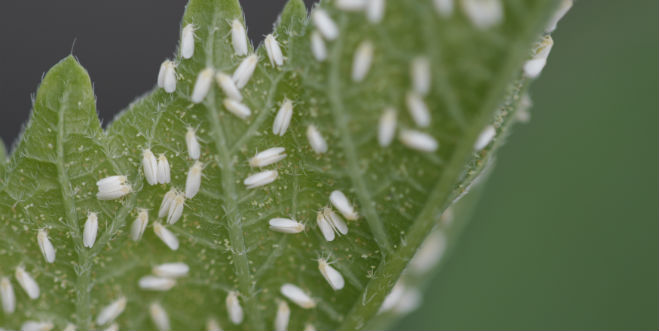Jun 16, 2016Whitefly species to cause growers problems, expert says
A University of Florida Institute of Food and Agricultural Sciences expert predicts the Q-biotype whitefly discovered in April in Palm Beach County will likely cause problems for growers.
The Q-biotype whitefly – not to be confused with the B-biotype, which came to Florida in the mid-1980s – is now being seen outside greenhouses and nurseries and poses a threat to ornamental plants and agricultural crops. After the B-biotype was found in Florida in the 1980s, scientists saw big increases in the diversity and frequency of whitefly-transmitted viruses in many Florida crops, said Jane Polston, a UF/IFAS plant pathology professor. Crops like beans, tomato, watermelon and squash were hit hard by these viruses after the appearance of the B biotype.
“This Q-biotype is a pest that damages crops and resists many of the insecticides that are effective on the B-biotype, the whitefly that is common in many ornamental and vegetable crops,” Polston said. “And like other whiteflies, it is capable of transmitting viruses from one plant to another.”
But because the Q-biotype whitefly feeds for longer periods on some plants, it has a greater chance of acquiring a plant virus, Polston said. The more time a whitefly spends feeding on a plant, the more likely it is to acquire a virus from an infected plant. Only a few studies have been conducted on the host plants that Q and B feed on, but those few studies indicate that Q and B do have different preferences, she said.
Because these whitefly species feed differently, vegetable and ornamental crop growers may see different viruses in their crops, as well as how many plants become infected each season, Polston said.
“And because it’s harder to manage with pesticides, we may see higher populations of this new whitefly, and that can mean high numbers of virus-infected plants,” Polston said.
Viruses may show up in plants that were not infected before, Polston said. Scientists and Extension faculty also should be prepared to see changes in the percentage of infected plants on farms, she said.
In other words, the Q-biotype whitefly is not simply an insect management issue; the insect also transmits viruses, she said.
This whitefly can transmit many different plant viruses, such as Tomato yellow leaf curl virus, Squash vein yellowing virus, Tomato infectious chlorosis virus, Cowpea mild mottle virus, and many others, according to a 2013 paper that Polston co-wrote.
Known scientifically as Bemisia tabaci, the Q-biotype or Mediterranean whitefly is a light-colored, flying insect slightly less than 1 millimeter in length.
When the whitefly was reported this spring, it marked the first time the Q-biotype of Bemisia tabaci had been found outside a greenhouse or nursery in the United States since it was found on an ornamental plant in a greenhouse in 2004-2005, said Lance Osborne, a UF/IFAS entomology professor.
Researchers with UF/IFAS are working with the U.S. Department of Agriculture, Agricultural Research Service and the Florida Department of Agriculture and Consumer Services to manage the whitefly.
— Brad Buck, University of Florida
Source: UF/IFAS















